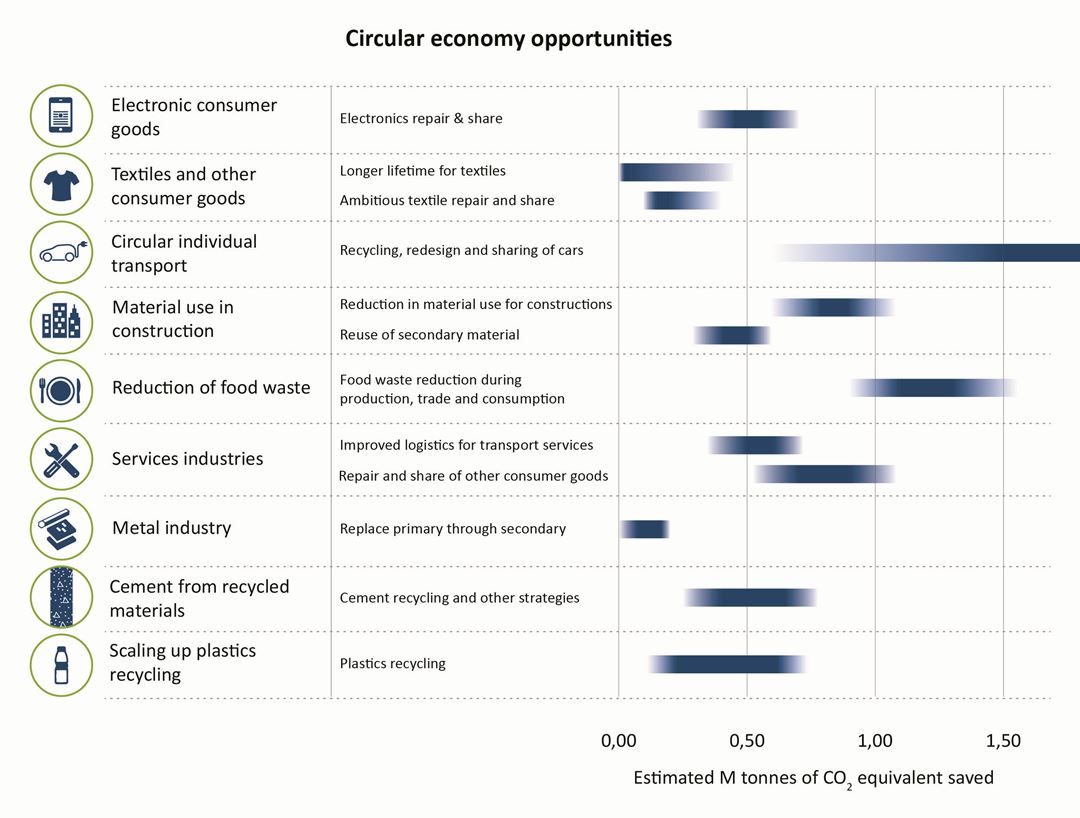Circular economics is about making the most out of our resources, ensuring sustainability and value creation in both short and long term. Attempts are made to close the material loops to prevent resources being lost and at the same time prolong their lifetime, so that the value and quality of the resources remain as high as possible for as long as possible. The products and materials that our society relies on lead to greenhouse gas emissions in different parts of their value chain, either at manufacturing or use stage or at the end of the life cycle. At the same time, the green shift and conversion to the low-emission community lead to the use of more scarce resources, which affects the resource situation.
Total GHG emissions in Norway in 2018 were approximately 54Mt CO2e. We estimate that between approximately 6 – 10 Mt CO2e of emissions in Norway and abroad can be saved through the selected circular strategies analysed in this report alone with further savings possible should Norway adopt a fully encompassing national circular economic model.

The report also summaries the barriers that are preventing these circular strategies today and how they might be resolved such as the use of digital tools that can provide an information platform are a prevalent need as are regulatory incentives for increased use of secondary materials, and to make share and repair of consumer goods more economically attractive. Recurring enablers for many of the circular strategies are:
- Strengthened requirements for sorting of waste and increased collaboration across the value chain to improve on product recyclability
- Improved production planning and decision support across the supply chains
- Long-term public and private RD&D investments in new circular economy enabling innovations
- Reform of tax system, prolonging economic lifetime of capital goods and penalising the use of materials and non-renewable energy instead of labour
- Focusing on consumer education and changing public attitudes towards waste minimisation
- Stimulation of the markets for secondary materials and products
- Digitalization for improved logistics, embedded information about materials, and platforms for sharing, and better utilization of side-streams and by-products
The Circular Economy will also be a critical enabler of the transition to a low emission society, which will demand a large volume of materials, including critical elements. Establishing large infrastructure projects will increase the need for basic materials for construction and energy projects, such as concrete, steel, and aluminium. In addition, the production of low-carbon technologies depends on critical materials such as platinum-group and rare-earth metals, for which future prices and availability are uncertain.
The large amount of critical materials are needed for the growth of low-carbon technology in the next decades – representing a significant share of current primary production capacity – highlights the need for circular economy measures for critical materials. These include increasing recycling rates and the use of secondary materials, improving material efficiency, and extending the lifetime of in-use stocks. Despite increasing research and development in the recovery and recycling of critical materials from 3 electronic waste, solar cells, permanent magnets, fuel cells, and Li-ion batteries, the technology is yet mostly immature and has limited commercial availability.
This study concludes that to achieve emission reduction via circular economic principles consumption must be reduced and channelled towards more sustainable, higher quality and longer lasting products. Producers and wholesale/retail trade services must offer and promote the more sustainable options. This includes not only goods that are designed for repair and reuse and to reduce material use and emissions, but also new business models offering leasing, repair and share services. Material reuse and recycling strategies must become the norm rather than the exception, this is especially important in the context of new low-carbon technologies.
The transition to a circular economy entails a system change, with wide ranging environmental, societal and economic impact along global supply chains. This study highlights the impact the circular economy opportunities can have on greenhouse gas emissions and further analysis should be carried out to find the impact of the case studied on economic value creation, job creation, waste generation, ecological impact and more. Achieving the adoption of a circular economic model requires participative and collaborative inter-disciplinary actions across various levels which need to be fostered and supported across branches and sectors.

